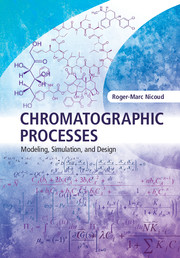Book contents
- Frontmatter
- Contents
- Preface and acknowledgments
- 1 Our approach to modeling chromatographic processes
- 2 Linear chromatography: the Russian Lego
- 3 Non-linear chromatography: equilibrium theory
- 4 Fluid–solid phase equilibria
- 5 Mass transfer
- 6 Hydrodynamics of chromatographic columns
- 7 Simulating chromatographic columns
- 8 Counter-current systems
- 9 Chromatographic modes and their optimization
- 10 Addressing a few industrial problems
- 11 Conclusion
- Appendix A Some important properties of the Laplace transform
- Appendix B Inlet and outlet boundary conditions
- Appendix C Equilibrium theory: single-solute chromatograms
- Appendix D Equilibrium theory: binary chromatograms
- Appendix E The influence of the porosity determination on chromatographic modeling
- Appendix F Useful physico-chemical data and orders of magnitude
- Appendix G Fick and Maxwell–Stefan approaches to diffusion
- Appendix H Non-linear LDF for multi-solute systems
- Appendix I Situations that make the use of the MC model problematic
- Appendix J Typical industrial chromatographic processes
- Notation
- Index
- References
9 - Chromatographic modes and their optimization
Published online by Cambridge University Press: 05 April 2015
- Frontmatter
- Contents
- Preface and acknowledgments
- 1 Our approach to modeling chromatographic processes
- 2 Linear chromatography: the Russian Lego
- 3 Non-linear chromatography: equilibrium theory
- 4 Fluid–solid phase equilibria
- 5 Mass transfer
- 6 Hydrodynamics of chromatographic columns
- 7 Simulating chromatographic columns
- 8 Counter-current systems
- 9 Chromatographic modes and their optimization
- 10 Addressing a few industrial problems
- 11 Conclusion
- Appendix A Some important properties of the Laplace transform
- Appendix B Inlet and outlet boundary conditions
- Appendix C Equilibrium theory: single-solute chromatograms
- Appendix D Equilibrium theory: binary chromatograms
- Appendix E The influence of the porosity determination on chromatographic modeling
- Appendix F Useful physico-chemical data and orders of magnitude
- Appendix G Fick and Maxwell–Stefan approaches to diffusion
- Appendix H Non-linear LDF for multi-solute systems
- Appendix I Situations that make the use of the MC model problematic
- Appendix J Typical industrial chromatographic processes
- Notation
- Index
- References
Summary
Optimizing for sure … but what and how?
Introduction
Options for implementing purification systems based on chromatographic processes are almost infinite in number, limited only by the creativity of the engineer. Even for a given chromatographic medium, one can vary the carrier fluid composition, use singlecolumn or multi-column systems, connect columns in different ways, recycle partly purified fractions, change flow directions, take advantage of physical or chemical modulations and so on. These different ways of implementing chromatography for a given chromatographic medium are called chromatographic modes. A variety of articles presenting and comparing chromatographic modes have been published Bailly and Tondeur (1984); Wankat (1986a,b); Nicoud and Perrut (1991); Nicoud (1992); Tondeur and Bailly (1993a,b); Seidel-Morgenstern (1998); Kaspereit et al. (2012). Trying to find the best mode to systematically surpass the others is probably hopeless: if insulin is normally produced on batch chromatography columns, para-xylene on 24-column SMB systems and optical isomer separations on 6-column SMB or Varicol, there are certainly good reasons for that. The different chromatographic modes have to be considered as different tools belonging to the same toolbox: according to the problem to be solved, the right tool has to be used.
Prior to presenting our approach to optimization, let us describe a few process alternatives. The subsequent sections are not aimed at presenting a complete list of reported options, but rather at giving food for thought.
Presentation of chromatographic modes
9.2.1 Single-column systems
The simplest way of operating preparative chromatography is so-called elution chromatography, based on periodic injections of a mixture at the inlet of a single column, purified fractions being collected at the outlet. The basic principle is therefore equivalent to analytical chromatography, even if the objective is different.
The industrial efficiency of batch elution chromatography is certainly related to the ability to build high-efficiency columns (expressed in number of plates). The main evolution is from dynamic axial compression technology, permitting stable and efficient beds (Colin et al., 1990).
- Type
- Chapter
- Information
- Chromatographic ProcessesModeling, Simulation, and Design, pp. 497 - 560Publisher: Cambridge University PressPrint publication year: 2015

